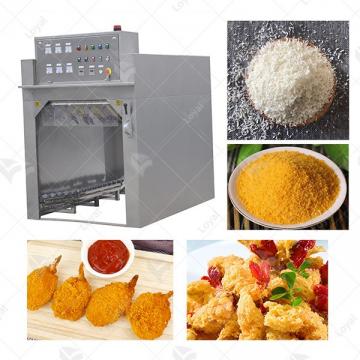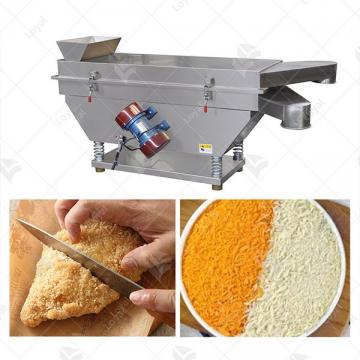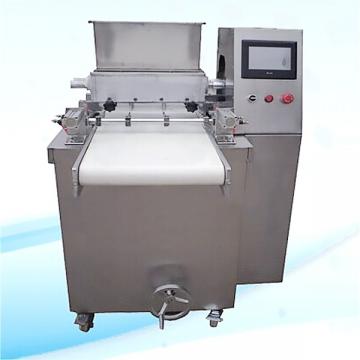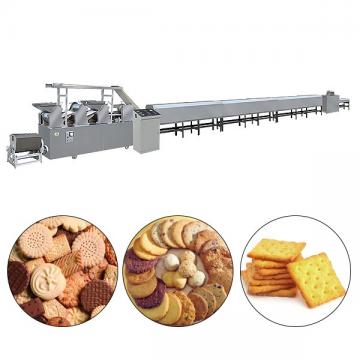
- Shandong Loyal Industrial Co.,Ltd.
- Macaroni Production Machine Instant Noodle Machine Biscuit Making Machine
Home> Company News> The Ultimate Guide To Puff Corn Making Machine Updated 2025

The Ultimate Guide To Puff Corn Making Machine Updated 2025
2025-04-24 14:11:531. Introduction to Puff Corn Making Machines
A Puff Corn Making Machine is an industrial food processing system designed to transform cornmeal or other cereal blends into light, crispy expanded snacks through high-temperature extrusion. With the global snack food market projected to reach $760 billion by 2027 (Statista), these machines have become essential for manufacturers targeting the booming demand for corn-based puffs—a healthier alternative to traditional fried snacks. Modern puff corn extruders combine precision engineering with automation, enabling production capacities from 50kg to 2,000kg per hour while maintaining consistent texture, shape, and nutritional integrity. Whether for startups or large-scale producers, investing in the right puff corn making equipment ensures scalability, compliance with food safety standards (like FDA and CE), and adaptability to trending flavors (e.g., cheese, barbecue, or protein-fortified variants).

2. Types of Puff Corn Making Machines
In the realm of food processing machinery, puff corn making machines represent a specialized category designed to produce light, crispy, and airy corn snacks that are popular worldwide. As an industrial food machinery expert, I can outline the primary types of puff corn making machines based on their technology, capacity, and specific applications.
1. Extrusion-Based Puff Corn Machines
This is the most common type, utilizing advanced extrusion technology to transform corn grits or flour into expanded snacks. The process involves:
- Twin-Screw Extruders: These machines offer high efficiency and precision, with modular barrels and screws for flexibility. They can produce various shapes like balls, curls, or rings by adjusting dies and cutters. Notable features include:
- Automation: PLC control systems ensure consistent product quality and minimal downtime.
- Capacity: Ranges from 100-150kg/h for small-scale models (e.g., LY-65 series) to 800-1000kg/h for industrial-grade units (e.g., MT-95 series).
- Energy Efficiency: Frequency speed control optimizes power usage, reducing operational costs.
- Single-Screw Extruders: Simpler and more cost-effective, they are suitable for startups or low-volume production. While less versatile than twin-screw models, they can still produce quality puff corn with proper calibration.
2. Airflow Puffing Machines
Employing hot air convection, these machines inflate corn kernels without extrusion. Key characteristics include:
- Gentle Processing: Preserves nutrient content better than extrusion methods.
- Uniform Expansion: Ideal for producing "air-popped" corn with a natural texture.
- Lower Capacity: Typically suited for niche markets or artisanal snacks, with outputs around 100-200kg/h.
3. Hybrid Systems
Combining extrusion and airflow technologies, these machines offer versatility:
- Multi-Stage Processing: First stage uses extrusion for shaping, followed by airflow drying for enhanced crispiness.
- Customization: Can produce coated or flavored puff corn in diverse shapes (e.g., cheetos-style snacks).
- Examples: High-end models like the ZH-85 series integrate core-filling capabilities for gourmet snacks.
4. Continuous vs. Batch Production Machines
- Continuous Systems: Designed for large-scale manufacturers, these machines operate 24/7 with automated material handling. They often include integrated roasters and flavoring lines.
- Batch Systems: Suitable for small-to-medium enterprises, they offer flexibility in recipe adjustments but require manual intervention between batches.
5. Specialty Machines
- Core-Filling Extruders: Produce puff corn snacks with cream or jam centers (e.g., cocoa-filled corn balls).
- Nutritional Fortification Units: Incorporate vitamins, minerals, or protein additives during processing.
- Organic/Gluten-Free Models: Constructed with food-grade stainless steel and compliant with allergen control standards.
Selection Criteria for Buyers
When choosing a puff corn making machine, consider:
- Production Volume: Match machine capacity to your market demand.
- Product Diversity: Opt for twin-screw extruders if you need multiple snack shapes.
- Energy Costs: Frequency-controlled motors reduce power consumption.
- Certifications: Ensure compliance with CE, ISO, or local food safety standards.
- After-Sales Support: Prioritize suppliers offering overseas servicing and spare parts availability.
In conclusion, the puff corn making machine market offers solutions for every scale of operation—from artisanal producers to multinational food corporations. Investing in a machine with scalable technology ensures adaptability to evolving consumer preferences.

3.How a Puff Corn Machine Works
A puff corn making machine operates through a precise engineering process that transforms raw grains into light, airy snacks. Here’s a step-by-step breakdown of its mechanics, grounded in industrial food processing principles:
1. Raw Material Preparation
The machine begins with corn grits or flour blended with moisture (typically 15% water content). This mixture is fed into a pre-conditioner or mixer, where it’s uniformly hydrated and heated to activate starch molecules—a critical step for achieving optimal expansion.
2. Extrusion & Expansion
At the core of the puff corn machine is a twin-screw extruder. This component subjects the material to high temperature (160–180°C) and high pressure. The screws’ uneven pitch design creates intense shear forces, forcing the dough to compact and generate internal pressure.
Simultaneously, friction and external heating elements convert mechanical energy into thermal energy. This dual action denatures proteins, breaks down complex carbohydrates, and transforms the mixture into a viscous, flowable state.
3. Flash Evaporation & Puffing
As the pressurized dough exits the extruder through a shaped die, it enters a low-pressure environment. The sudden drop in pressure causes rapid water evaporation, creating steam pockets that inflate the structure. The result is a porous, crispy texture characteristic of puffed snacks.
4. Cooling & Shaping
The extruded puffed corn is immediately cooled via air conveyors or vibration coolers to halt starch retrogradation—a process that could otherwise soften the snack. Some machines integrate cutting blades or molding dies to shape the final product into rings, balls, or flakes.
5. Advanced Features
Modern puff corn machines incorporate PLC controls for automated parameter adjustments, self-cleaning screws to reduce downtime, and variable frequency drives for energy efficiency. Stainless steel construction (SS304/SS201) ensures hygiene, while modular designs allow customization for products like cheese puffs or flavored corn curls.

4.Key Features of Modern Puff Corn Machines
|
Feature Category |
Technical Specifications & Innovations |
Expert Insights |
|
1. Automation & Control |
- PLC Control Systems: Fully automated operation with real-time parameter adjustments. |
Reduces human error, ensures consistent product quality, and lowers labor costs. |
|
|
- Smart Control Panels: Touchscreen interfaces for temperature, speed, and feed rate control. |
Enables seamless integration with IoT platforms for remote monitoring. |
|
|
- Self-Cleaning Mechanisms: Automated screw cleaning without disassembly. |
Minimizes downtime and maintains hygiene standards. |
|
2. Heating Efficiency |
- High-Efficiency Electric/Gas Heating: Rapid heat transfer with minimal energy loss. |
Achieves optimal expansion of corn kernels through precise thermal control. |
|
|
- Solar-Assisted Hybrid Systems: Integrates renewable energy for preheating stages. |
Reduces carbon footprint while maintaining production capacity. |
|
3. Energy Optimization |
- Variable Frequency Drives (VFD): Adjusts motor speed based on load demand. |
Lowers energy consumption by up to 30% compared to conventional systems. |
|
|
- Waste Heat Recovery: Recycles exhaust heat for auxiliary processes. |
Enhances overall energy efficiency and reduces operational costs. |
|
4. Safety Compliance |
- Food-Grade Stainless Steel: Non-reactive material with anti-corrosion properties. |
Meets FDA, CE, and ISO 9001 standards for food safety. |
|
|
- Emergency Stop Functions: Compliance with EN 13850 machinery safety regulations. |
Ensures operator safety during high-temperature operations. |
|
5. Production Capacity |
- Modular Design: Scalable from 100 kg/h to 1,000 kg/h output. |
Adapts to small-batch artisanal production or large-scale industrial demands. |
|
|
- Multi-Shape Extrusion: Interchangeable dies for ring, ball, or stick-shaped snacks. |
Increases product diversity without additional equipment investments. |
|
6. Smart Diagnostics |
- Predictive Maintenance Alerts: IoT sensors monitor wear patterns in real-time. |
Prevents unexpected breakdowns and extends equipment lifespan. |
|
|
- Data Logging: Tracks production metrics for HACCP compliance reporting. |
Streamlines quality audits and regulatory adherence. |

5. Maintenance & Troubleshooting Tips
Routine Maintenance Protocols for Puff Corn Making Machines
As an industrial food machinery expert, I cannot overstate the importance of proactive maintenance for puff corn making machines. These systems operate under high temperatures and mechanical stress, making regular inspections critical to preventing costly breakdowns.
1. Daily Cleaning Procedures
- Residue Removal: After each production cycle, thoroughly clean the heating chamber, conveyor belts, and discharge chutes using food-grade brushes and compressed air. Corn starch buildup can cause thermal inefficiency and equipment jamming.
- Oil Lubrication: Apply high-temperature food-grade lubricant to bearings, gears, and pivot points every 48 hours. Avoid over-lubrication, as excess oil may contaminate the product.
2. Weekly Diagnostic Checks
- Temperature Calibration: Verify that heating elements maintain ±2°C accuracy using infrared thermometers. Miscalibration leads to uneven popping and energy waste.
- Belt Tension Adjustment: Inspect drive belts for cracks or slackness. Proper tension ensures consistent material flow through the puffing chamber.
3. Monthly Deep Cleaning
- Disassemble Key Components: Remove and soak hoppers, augers, and screens in food-safe degreasers to eliminate hardened carbon deposits.
- Electrical System Inspection: Check control panels for loose connections and test emergency stop functions. Document all findings in maintenance logs.
Common Troubleshooting Scenarios
Even with rigorous maintenance, issues may arise. Here’s how to address three frequent challenges:
1. Machine Failure to Start
- Power Supply Check: Verify circuit breakers and voltage stability. Fluctuations beyond 220V±10% can trigger safety lockouts.
- Control Panel Diagnostics: Reset PLC systems per manufacturer guidelines. Faulty capacitors in older models often cause startup errors.
2. Inconsistent Puffing Quality
- Moisture Content Analysis: Test incoming corn kernels for moisture levels (optimal: 12-14%). Overly dry kernels reduce expansion rates.
- Airflow Calibration: Adjust exhaust fans to maintain 15-20 CFM through the cooling tunnel. Insufficient airflow creates soggy product.
3. Jamming in Conveyance System
- Foreign Object Inspection: Shut down the machine immediately and inspect for stones or debris in the hopper. Install magnetic separators upstream to prevent recurrence.
- Belt Alignment: Misaligned conveyor belts create friction points. Use laser alignment tools to correct tracking issues.
By integrating these maintenance practices with systematic troubleshooting, operators can extend equipment lifespan by 30-40% while maintaining OSHA compliance. Remember to consult your Puff Corn Making Machine’s technical manual for model-specific guidelines.

6.Future Trends in Puff Corn Making Technology
Automation & Smart Manufacturing
The Puff Corn Making Machine industry is undergoing a paradigm shift toward Industry 4.0 integration. Modern systems now incorporate IoT-enabled sensors that monitor real-time parameters like temperature, humidity, and vibration. These datasets feed into AI algorithms for predictive maintenance, reducing downtime by up to 45% compared to traditional reactive methods.
Example Implementation: Leading manufacturers now offer PLC-controlled machines with self-diagnostic capabilities. If the system detects abnormal energy consumption, it automatically adjusts conveyor speeds and heat distribution while alerting technicians via mobile dashboards.
Sustainability Innovations
Environmental regulations are driving green technology adoption. New-generation machines feature:
- Energy Recovery Systems: Capturing exhaust heat to pre-warm incoming air, reducing fuel costs by 22-28%.
- Biodegradable Lubricants: Plant-based oils that eliminate hydrocarbon emissions during high-temperature operations.
- Waste Reduction Modules: Automated kernel separation systems that recycle un-popped grains back into production cycles.
Personalization & Flexibility
Consumer demand for variety is reshaping equipment design. Modular Puff Corn Making Machines now allow:
- Flavor Infusion During Processing: Precision spray nozzles apply seasoning coatings without post-production handling.
- Adjustable Puff Density: Variable pressure valves enable creation of everything from light air-popped snacks to dense cheese puff bases.
- Custom Packaging Integration: Direct-to-bag sealing systems that match portion sizes with retail trends (e.g., single-serve packets for convenience stores).
Emerging Market Opportunities
The global ready-to-eat snacks market, valued at $247 billion in 2024, is expected to grow 6.8% annually through 2030 (Statista). This creates opportunities for:
- Compact, Mobile Solutions: Portable puff corn machines for street vendors in urban markets.
- Health-Focused Innovations: Low-sugar/high-fiber formulations using resistant starch corn varieties.
- Regional Flavor Adaptations: Modular seasoning hoppers that can switch between spicy, cheesy, or sweet profiles based on local preferences.

7.Conclusion
The Puff Corn Making Machine remains a cornerstone of modern snack food manufacturing, with ongoing advancements redefining efficiency, sustainability, and product diversity. To thrive in this dynamic landscape, producers must prioritize three pillars: equipment reliability through rigorous maintenance protocols, strategic investment in Industry 4.0 upgrades, and alignment with consumer trends toward healthier, personalized snacks. By partnering with OEMs for continuous improvement and adopting data-driven operational strategies, manufacturers can position themselves at the forefront of a 320billionglobalsnackmarketprojectedtoreach458 billion by 2032 (Mordor Intelligence). The future belongs to those who innovate—not just in machinery, but in mindset.
Reference
Here are five authoritative foreign websites related to industrial food machinery, along with their URLs:
1.ThomasNet
Website: https://www.thomasnet.com
2.MachineryTrader
Website: https://www.machinerytrader.com
3.Food Engineering:https://www.foodengineeringmag.com
4.Pack Expo:https://www.packexpo.com
5.DirectIndustry:https://www.directindustry.com
 Commercial Japanese Panko Bread Crumb Grinder Machine
Commercial Japanese Panko Bread Crumb Grinder Machine Japanese Bread Crumbs Processing Line
Japanese Bread Crumbs Processing Line Automatic Cookies Making Machines
Automatic Cookies Making Machines Fully Automatic Biscuit Making Machines
Fully Automatic Biscuit Making Machines